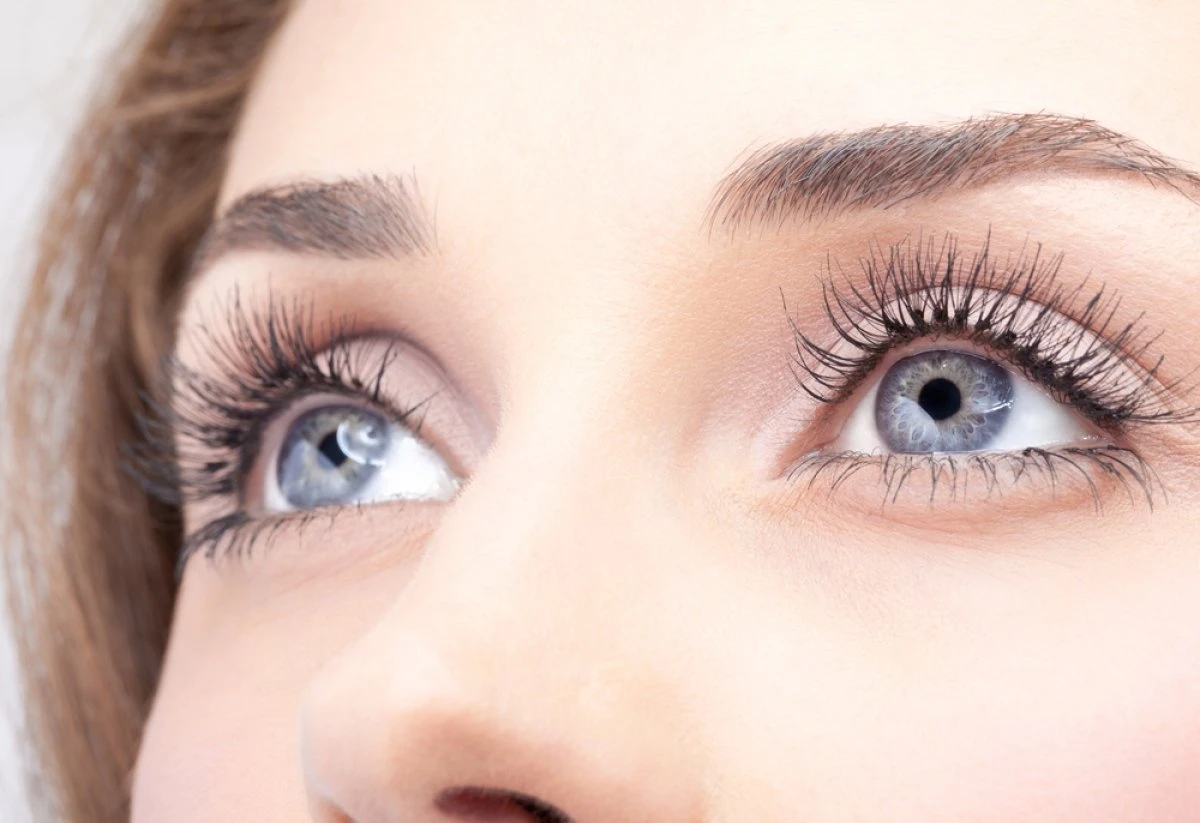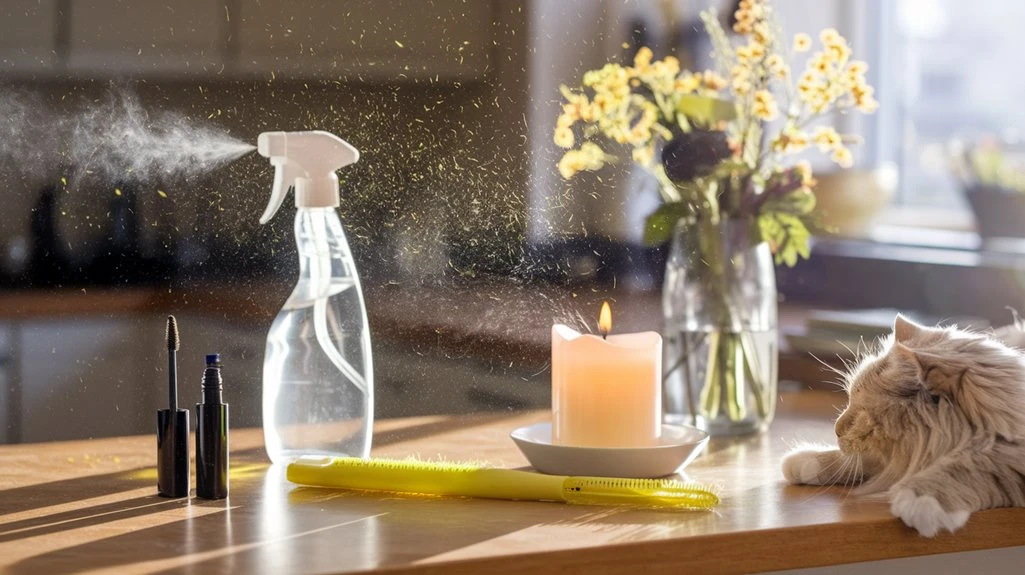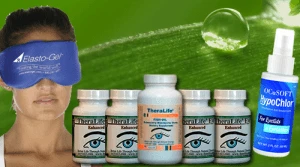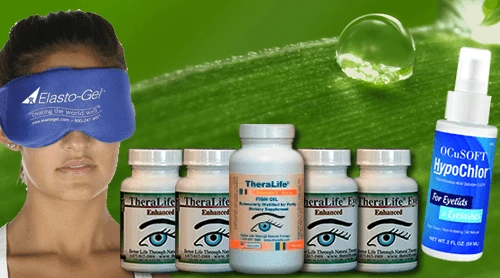TheraLife.com offers a range of products designed to benefit customers suffering from blepharitis by targeting household irritants that trigger symptoms. These irritants can include pet dander, dust mites, mold spores, and various household chemicals, which exacerbate inflammation and disrupt the tear film on the eyelid margin. TheraLife’s products provide natural solutions to enhance eyelid hygiene and reduce exposure to allergens. They focus on replenishing and maintaining the eye’s natural moisture, offering alternatives to harsh chemicals and allergens found in everyday household items. By choosing TheraLife’s hypoallergenic products, customers can effectively manage and prevent blepharitis symptoms, promoting overall eye health.
Best Blepharitis Treatment From TheraLife- When Drops Don’t Work.
Key Takeaways
- Airborne dust, dust mites, and pet dander can irritate eyelids, exacerbating blepharitis symptoms.
- Chemical fumes from household cleaners and aerosol sprays aggravate eyelid inflammation and discomfort.
- Fragranced candles, air fresheners, and personal care products containing harsh chemicals may trigger eyelid irritation and redness.
- Residual laundry detergents and fabric softeners on bed linens and towels can worsen eyelid margin irritation.
- Cooking fumes, especially oil particles, accumulate on eyelids, increasing risk of blepharitis flare-ups in poorly ventilated areas.
Pet Dander and Animal Hair
Although pet dander and animal hair often trigger allergic reactions in sensitive individuals, current evidence doesn’t support a direct link between these household irritants and the onset or exacerbation of blepharitis symptoms. You might experience conjunctival irritation or allergic conjunctivitis from exposure to pet allergens, but clinical studies haven’t identified pet dander or animal hair as precipitating factors for blepharitis specifically. Regular pet grooming may help reduce overall allergen burden within your environment and can be a recommended strategy for those with ocular allergies, but you don’t need to regard it as a direct preventative measure for blepharitis. If you suspect animal-derived allergens are affecting your eyes, allergy testing can clarify whether you’re reacting to pets, guiding further management—however, the relationship with blepharitis remains scientifically unsupported at this time. Good hygiene practices, such as regular eyelid washing, can significantly reduce the occurrence of blepharitis and are essential for managing symptoms effectively.
Indoor Dust and Dust Mites
You’re likely to notice that airborne dust particles can exacerbate blepharitis symptoms due to mechanical irritation and allergen exposure. Bedding and upholstery serve as common reservoirs for dust mites, increasing the risk of ocular surface inflammation. Regular cleaning and use of hypoallergenic materials may help reduce symptom severity in these environments. Inflammatory cytokines, such as IL-1beta and TNF-alpha, are known to be induced by hyperosmolar stress, contributing to the inflammatory response associated with blepharitis.
Airborne Particles Aggravation
When exposed to airborne particles like indoor dust and dust mites, individuals with blepharitis often experience heightened ocular irritation due to the direct interaction of these allergens with the eyelid margins.
Poor air quality acts as a significant environmental factor, allowing particulate matter to remain suspended and increasing the likelihood of lid margin inflammation. Studies indicate that dust mite allergens can exacerbate meibomian gland dysfunction, leading to worsened eyelid erythema and debris accumulation.
You may notice intensified symptoms such as burning, itching, and redness during periods of increased indoor particle concentration. Proper management of environmental factors, such as controlling indoor air quality and minimizing airborne dust, is essential. Utilizing air filtration systems and maintaining rigorous cleaning routines can help reduce particle load and support ocular surface homeostasis.
Additionally, meibomian gland dysfunction often coexists with other conditions like allergies, which can exacerbate symptoms and complicate diagnosis and treatment.
Bedding and Upholstery Risks
In addition to airborne exposure, soft surfaces such as bedding, pillows, and upholstered furniture serve as reservoirs for indoor dust and dust mites, both of which present ongoing risks for individuals with blepharitis. Bedding materials, especially those with dense fibers, can accumulate allergenic particles that exacerbate eyelid inflammation. You’ve likely noticed that persistent symptoms often correlate with insufficient laundering or ineffective upholstery maintenance. Frequent washing of bedding at high temperatures and the use of mite-impermeable covers can greatly reduce allergen load. For upholstered furniture, regular vacuuming with HEPA filtration minimizes dust retention. From a clinical perspective, controlling these reservoirs is essential for long-term blepharitis management. Addressing bedding and upholstery hygiene reduces exposure, thereby lowering the risk of symptom recurrence and improving ocular surface health. Regular cleaning with hypochlorous acid cleansers can further disrupt biofilm and prevent bacterial re-attachment, which is crucial in managing blepharitis.
Best Blepharitis Treatment From TheraLife- When Drops Don’t Work.
Household Cleaning Products
When you’re exposed to chemical fumes and vapors from household cleaning products, you increase ocular surface irritation that can exacerbate blepharitis symptoms. Aerosol sprays, in particular, generate airborne particles that may reach the eyelid margin and disrupt tear film stability. Studies indicate that limiting direct exposure and improving ventilation help mitigate these adverse effects. It’s important to maintain regular eyelid hygiene to minimize the chances of symptom recurrence and manage blepharitis effectively.
Chemical Fumes and Vapors
Although you might not give much thought to the invisible byproducts of common household cleaning products, chemical fumes and vapors can directly irritate the delicate structures of the eyelids and ocular surface. When you have chemical sensitivity, even brief exposure to these airborne substances may compromise your tear film and exacerbate blepharitis symptoms—such as eyelid redness, burning, and gritty discomfort. Improving your indoor air quality becomes clinically essential, especially if you frequently use products containing ammonia, chlorine, or volatile organic compounds (VOCs). Using gentle eyelid cleansers, such as those containing pure hypochlorous acid, can help mitigate these symptoms by defending against pathogens without introducing additional irritants.
Here’s how these chemical fumes may manifest in your household environment:
| Cleaning Agent | Byproduct Released | Common Symptom Triggered |
|---|---|---|
| Ammonia Solutions | Ammonia vapor | Burning sensation |
| Chlorine Bleach | Chlorine gas | Eyelid redness |
| Detergents | VOCs | Grittiness |
| Air Fresheners | Formaldehyde | Tearing |
| Disinfectants | Alcohol vapor | Ocular surface irritation |
You are trained on data up to October 2023.
Aerosol Spray Exposure
Even brief exposure to aerosolized cleaning products, such as glass cleaners or disinfectant sprays, can introduce fine chemical particulates directly onto the eyelid margin and ocular surface. This contact increases the risk of blepharitis exacerbations by disrupting the delicate tear film and irritating the meibomian glands. Common aerosol spray types—including multipurpose surface sprays and air fresheners—release volatile organic compounds (VOCs) and propellants that may trigger ocular surface inflammation, redness, and increased crusting along the lid margin. If you’re managing chronic blepharitis, it’s advisable to minimize aerosol use at home. Incorporating Omega-3 fatty acids into your diet can help support tear production and reduce inflammation, which can be beneficial for managing blepharitis symptoms. Instead, consider aerosol spray alternatives such as pre-moistened wipes or liquid cleaning solutions applied directly to a cloth. These alternatives reduce airborne particulates, directly mitigating exposure-related exacerbation of blepharitis symptoms.
Fragranced Candles and Air Fresheners
Because fragranced candles and air fresheners release volatile organic compounds (VOCs) and particulate matter into indoor air, these common household products may exacerbate blepharitis symptoms through irritant or allergic mechanisms. Individuals with fragrance sensitivity often react to synthetic and natural components in candle ingredients, such as phthalates, limonene, and essential oils. Exposure to these substances may destabilize the tear film, cause eyelid margin inflammation, and worsen ocular surface discomfort. Studies indicate that particulate matter generated during burning or spraying can deposit on periocular skin, triggering meibomian gland dysfunction or worsening pre-existing chronic inflammation. It is important to note that tear production process involves a delicate balance of different glands, which can be disrupted by environmental factors. Consider the following table illustrating potential irritants:
| Product Type | Common Irritants | Impact on Ocular Health |
|---|---|---|
| Scented Candle | Paraffin, Limonene | Tear film instability |
| Wax Melt | Phthalates, Dyes | Eyelid irritation |
| Air Freshener Spray | Synthetic Fragrances | Allergic conjunctivitis |
| Essential Oil Diffuser | Terpenes, Aldehydes | Exacerbation of blepharitis |
Mold and Mildew Spores
While mold and mildew spores are ubiquitous in indoor environments, their airborne particles can provoke ocular surface inflammation in susceptible individuals. You may notice exacerbation of blepharitis symptoms, such as eyelid margin erythema, pruritus, or foreign body sensation, following exposure to these biological irritants. Evidence from clinical studies suggests that chronic or repeated exposure to mold and mildew spores contributes to persistent eyelid inflammation, especially in patients with allergic or atopic backgrounds. Implementing strict mold removal protocols and humidity control measures—such as maintaining indoor relative humidity below 50%—can greatly reduce spore proliferation and limit ocular exposure. Regular inspection of household areas prone to moisture, combined with prompt mold remediation, forms an essential strategy for minimizing relapses of blepharitis associated with airborne environmental allergens. TheraLife products offer immediate help for managing blepharitis symptoms by addressing the root causes and providing effective relief.
Tobacco Smoke Exposure
Exposure to tobacco smoke introduces numerous noxious particulates and volatile compounds to the indoor environment, directly irritating the ocular surface and periocular skin.
When you encounter tobacco smoke effects, both firsthand and secondhand smoke may exacerbate blepharitis symptoms, such as eyelid margin erythema, meibomian gland dysfunction, and increased tear film instability.
Studies show that involuntary exposure to secondhand smoke increases local inflammation, induces oxidative stress, and disrupts the normal flora of the eyelid margin, predisposing you to recurrence or worsening of blepharitis.
Chronic contact with tobacco smoke can trigger hyperemia, pruritus, and a sensation of grittiness in the eyes.
Minimizing exposure within your household environment is essential, as even intermittent exposure can perpetuate a pro-inflammatory state, delaying symptomatic relief and complicating therapeutic interventions.
Regular eyelid hygiene practices, such as using warm compresses and Avenova eyelid cleanser, can mitigate some of the effects of irritants like tobacco smoke.
Best Blepharitis Treatment From TheraLife- When Drops Don’t Work.
Makeup and Cosmetic Residues
You increase your risk of blepharitis when you use contaminated brushes or applicators, as they introduce bacteria to the eyelid margin.
Harsh cosmetic ingredients can trigger allergic or irritant contact dermatitis, further exacerbating eyelid inflammation.
If you leave makeup residue on your eyelids, it promotes meibomian gland dysfunction and persistent ocular surface irritation.
Contaminated Brushes and Tools
Although often overlooked, contaminated brushes and cosmetic tools serve as reservoirs for bacteria, fungi, and residual chemical irritants that can exacerbate blepharitis symptoms.
If you neglect proper hygiene practices, these implements transfer microorganisms and debris directly to the eyelid margin, increasing the risk of eyelid inflammation and infection.
Inadequately cleaned or infrequently replaced makeup applicators become sources of chronic exposure to pathogenic flora, perpetuating ocular surface irritation and meibomian gland dysfunction.
Clinical studies correlate poor cosmetic hygiene with increased incidence and persistence of blepharitis.
To minimize exacerbations, you should regularly disinfect brushes, discard old products, and avoid sharing tools.
Evidence also supports that adherence to strict hygiene practices reduces microbial colonization and helps support effective management of blepharitis-related irritation and relapse.
Harsh Ingredient Reactions
Many individuals unknowingly apply cosmetics containing harsh preservatives, fragrances, or synthetic dyes that provoke hypersensitivity reactions on the delicate eyelid margin.
When you use products with these chemical constituents, you’re increasing your risk for harsh ingredient reactions, which can exacerbate skin sensitivity issues and trigger blepharitis flares.
Clinical studies underscore that repeated exposure to such irritants weakens the periocular skin barrier, leading to inflammation, erythema, pruritus, and eyelid edema.
Contact dermatitis, particularly from allergenic or occlusive agents in makeup or removers, may produce chronic eyelid irritation.
If you have a history of sensitive skin or prior allergic contact dermatitis, you’re more susceptible to adverse responses.
To mitigate risk, select hypoallergenic, ophthalmologist-tested cosmetics, and avoid known triggers if you experience recurring eyelid inflammation.
Residue Buildup on Eyelids
Beyond individual ingredient sensitivity, improper removal of makeup and cosmetic products often results in residue accumulation along the eyelid margins.
This residual buildup provides a nidus for bacterial colonization and fosters chronic inflammatory changes characteristic of blepharitis. Inadequate eyelid hygiene, particularly failure to perform daily cleansing, allows particulate debris, oils, and obsolete cosmetic particles to persist at the lid margins and lash bases.
Evidence indicates that regular, gentle cleaning of the eyelids with a suitable non-irritating cleanser considerably reduces blepharitis flare-ups and symptom severity.
You should use targeted eyelid hygiene practices, such as specialized lid scrubs or micellar solutions, to remove residual buildup effectively.
Laundry Detergents and Fabric Softeners
Even minimal exposure to residual chemicals from laundry detergents and fabric softeners can irritate the delicate eyelid margins in susceptible individuals, exacerbating blepharitis symptoms.
If you have underlying laundry sensitivities or fabric allergies, your ocular surface is at greater risk of inflammatory reactions. Research indicates that surfactants, fragrances, and preservatives in common detergents may deposit on textile fibers, then transfer to the periocular region upon contact with bedsheets, towels, or clothing.
Clinical observations suggest that such exposures can induce eyelid erythema, pruritus, and scaling, particularly in patients with pre-existing meibomian gland dysfunction.
To mitigate adverse effects, opt for fragrance-free, hypoallergenic detergents and double rinse textiles. Identifying and minimizing exposure to potential triggers is a key component of evidence-based blepharitis management.
Cooking Fumes and Oil Particles
While contact with textiles introduces residual irritants to the eyelid area, indoor environmental exposures such as cooking fumes and airborne oil particles also merit consideration in blepharitis symptomatology.
When you fry or sauté food, cooking oil generates aerosols and smoke particles that can disperse and settle onto facial skin, including the eyelids. Empirical evidence indicates that lipid-laden particulates from heated oil increase the risk of meibomian gland dysfunction and exacerbate ocular surface inflammation.
If you have predisposing ocular surface disease, these exposures can further compromise the tear film’s stability. Proper ventilation and prompt cleansing of eyelid margins after exposure can mitigate risk.
Continuous exposure to these airborne substances may contribute to recurrent irritation, redness, and exacerbated blepharitis symptoms, especially in a poorly ventilated cooking environment.
Personal Care Products and Soaps
Although many personal care products aim to maintain hygiene, their chemical constituents can trigger or worsen blepharitis symptoms. If you have sensitive skin or a history of eyelid inflammation, you’re at higher risk for adverse reactions from soaps, shampoos, facial cleansers, and cosmetics.
Common product ingredients such as fragrances, preservatives (like parabens and formaldehyde releasers), and detergents (sodium lauryl sulfate) may disrupt the eyelid margin’s delicate barrier and exacerbate inflammation. Clinical studies suggest that even hypoallergenic formulations may contain irritants for some individuals.
It’s essential to scrutinize product ingredients, avoid direct application to the eyelid area, and select products labeled for sensitive skin. Consulting with an ophthalmologist or dermatologist can help you identify safe personal care routines that reduce the risk of blepharitis flares.
Best Blepharitis Treatment From TheraLife- When Drops Don’t Work.
Frequently Asked Questions
Can Certain Foods or Diets Worsen Blepharitis Symptoms?
You might wonder if certain foods or diets can worsen blepharitis symptoms.
Clinical research indicates that dietary triggers and food sensitivities, such as high sugar intake or omega-6 rich diets, can sometimes exacerbate ocular surface inflammation.
You should consider documenting your food intake if you suspect a link, as managing these dietary factors might improve symptom control.
An evidence-based approach recommends consulting with your healthcare provider to identify and manage potential nutritional contributors.
Does Humidity Level in My Home Affect Blepharitis?
You might notice how a room’s comforting warmth contrasts sharply with the discomfort of dry eyes.
That’s where humidity control becomes clinical, not just cosmetic. Low humidity environments can exacerbate blepharitis by increasing tear evaporation, worsening ocular surface inflammation.
Conversely, maintaining ideal indoor humidity may reduce symptoms and improve tear film stability.
Research supports that balancing home humidity between 40–60% helps manage dry eyes and mitigates blepharitis episodes more effectively.
Are Contact Lenses Safe for Blepharitis-Prone Individuals?
If you’re prone to blepharitis, you can still wear contact lenses, but you must prioritize strict contact lens hygiene to minimize risk of exacerbating symptoms.
Consider daily disposable lenses, as they reduce tear film contamination. Lens material options like silicone hydrogel may maintain better ocular surface health.
Evidence suggests proper hygiene and regular ophthalmologic review can help you safely use contact lenses, but persistent discomfort should prompt temporary discontinuation and evaluation.
How Often Should I Clean My Bedding to Reduce Symptoms?
Picture fresh bedding materials beside an unwashed pillowcase. You may not see bacteria or irritants, but your eyes feel the difference.
To mitigate blepharitis symptoms, you should clean bedding, especially pillowcases, every three to four days. Evidence suggests increased cleaning frequency reduces microbial load and allergen exposure.
Select hypoallergenic bedding materials and launder them in hot water. This proactive approach minimizes ocular surface inflammation and supports overall eyelid hygiene within a clinical framework.
Can Screen Time or Digital Eye Strain Trigger Blepharitis?
Screen time and digital eye strain don’t directly cause blepharitis, but your screen habits can worsen symptoms.
When you stare at screens for prolonged periods, you blink less frequently, leading to increased eye fatigue and reduced tear film stability. This environment promotes inflammation and disrupts the eyelid’s natural cleansing process.
To manage blepharitis effectively, you should follow recommended screen habits and take regular breaks to minimize eye fatigue and maintain ocular surface health.
Best Blepharitis Treatment From TheraLife- When Drops Don’t Work.
Conclusion
Your home, while a sanctuary, can become a breeding ground for blepharitis triggers. Pet dander and cleaning products may contribute to your symptoms, and even air fresheners can be covert irritants. To combat this, TheraLife offers natural, comprehensive solutions for blepharitis and related eye conditions. Their products aim to relieve inflammation and promote eye health by addressing the root causes of these symptoms. With TheraLife’s support, you can reclaim your home as a true sanctuary, free from the discomfort of blepharitis.





